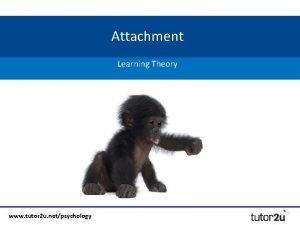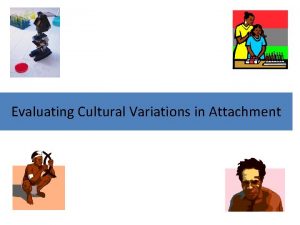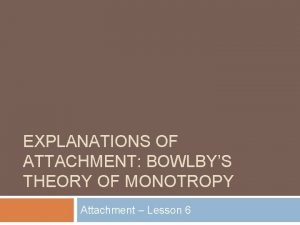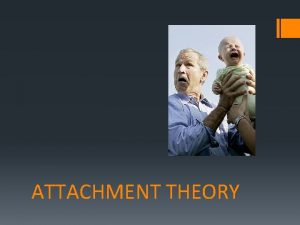Attachment Ms Carmelitano Evaluation of the Strange Situation













- Slides: 13

Attachment Ms. Carmelitano

Evaluation of the Strange Situation Paradigm • Combination of experimental and clinical methods • Naturalistic Experiment • Lamb (1985) argues that the data is artificial and limited • Unethical because of stress placed on baby � However it is modeled on common every day experiences • Cross cultural ▫ Focuses on the child’s reaction to the separation during the reunion ▫ Does not take into account the meaning of the separation may differ in each culture ▫ Japanese children are rarely separated from their mothers so this is a highly unusual situation

Types of Attachment • Type A – avoidant (20%): ▫ ▫ Shows indifference when mother leaves the room avoids contact with her when she returns Not Afraid of Strangers Mothers are insensitive and uninterested in child’s play ▫ ▫ Upset when mother leaves Happy when she returns Easily comforted by mother Mothers are interested in child’s play and support play and communicate with their children • Type B – securely attached (70%) • Type C – ambivalent 10%): ▫ ▫ Upset when mother leaves Difficulty being soothed when she returns Child seeks comfort but also rejects it Mothers are inconsistent in their reactions to their children

Main and Solomon (1986) • Propose a 4 th type of attachment • Type D (insecure-disorganized/disorientated attachment) ▫ The child shows no reaction when the mother leaves or comes back ▫ Associated with childhood abuse or depressed mother

Factors of Attachment • 1. Parental sensitivity (Ainsworth) ▫ Emotional response of the mothers ▫ Sensitive mothers will have a more securely attached baby • 2. Infant Temperament (Jerome Kagan 1982) ▫ Innate differences in children’s temperaments will influence how the environment interacts with them • 3. Family circumstances ▫ Some families cannot provide necessary support for the child (abusive families) ▫ Social conditions: poverty or death

Cross-Cultural Research on Attachment • Bowlby and Ainsworth do not designate one type as being “normative” ▫ according to theory of evolution, if a culture requires a child to suppress negative emotions, infants may develop avoidant attachment to meet cultural demand ▫ This will be the normal behavior

Turnbull (1973) • Studied the Ik, a small tribe living in a remote mountain in Uganda • Found no signs of parental love ▫ Parents were unhappy at the birth of a baby ▫ No signs of tenderness and affection ▫ Children were thrown out at an early age to take care of themselves • The Ik lived in conditions that put them near starvation ▫ This interfered with social relationships, and people adopted a very selfish way of life ▫ Self-Preservation evolved as being more important that child rearing, because they were a competition for food

Van Ijzendoorn and Kroonenberg (1988) • Meta-Analysis of 32 worldwide studies on attachment ▫ 8 countries ▫ 2000 infants • Findings ▫ Differences in distribution of types A, B, C ▫ Japan: Absence of type A, but high proportion of type C ▫ Type B is the most common cross-culturally ▫ Type A is more common in Western European Countries (Individualistic) ▫ Type C is more common in Japan (collective)

Role of Attachment for the Future • Hazan and Shaver (1987) ▫ Explored Bowlby’s theory of attachment in relation to adult romantic relationships ▫ It is used to explain positive emotions (caring, intimacy, trust) and negative (fear of intimacy, jealousy, emotional inconsistency)

Hazan and Shaver • Findings related to the inner workings model ▫ A person will form meaningful relationships if they have a positive inner workings model • Devised a “love quiz” in a newspaper and asked for respondents to indicated which pattern best described their feelings about relationships • Participants read three statements and indicated which best described their attitudes

Hazan and Shaver • Method: ▫ Self selected sample of 620 people age 14 -82, average being 36 204 makes 415 females ▫ A second study sampled 108 college students ▫ Participants also had to describe parents' parenting-styles using an adjective check list ▫ Findings: � 60% showed a secure attachment (parents = available, attentive, responsive) � 20% showed anxious-avoidant attachment (parents = unresponsive, rejecting, inattentive) � 20% showed anxious - ambivalent attachment (parents = anxious, sometimes responsive, generally out of touch with their needs)

The “Love Quiz” questions • A. I am somewhat uncomfortable being close to others, I find it difficult to trust them completely, difficult to allow myself to depend on them. I am nervous when anyone gets too close, and often, other want met o be more intimate than I feel comfortable being. • B. I find it relatively easy to get close to others and am comfortable depending on them and having them depend on me. I don’t worry about being abandoned or about someone getting too close to me • C. I find that others are reluctant to get as close as I would life. I often worry that my partner doesn’t really love me or won’t stay with me. I want to get very close to my partner and this sometimes scares people away.

Online Version • http: //psychology. about. com/library/quiz/blattachment-quiz. htm
 Mary ainsworth
Mary ainsworth Strange situation results
Strange situation results Strange situation experiment
Strange situation experiment Limitations of the strange situation
Limitations of the strange situation Tutor 2 u psychology
Tutor 2 u psychology Cultural variations in attachment evaluation
Cultural variations in attachment evaluation What is monotropic attachment
What is monotropic attachment Khi nào hổ con có thể sống độc lập
Khi nào hổ con có thể sống độc lập Từ ngữ thể hiện lòng nhân hậu
Từ ngữ thể hiện lòng nhân hậu Diễn thế sinh thái là
Diễn thế sinh thái là Lp html
Lp html Giọng cùng tên là
Giọng cùng tên là Vẽ hình chiếu vuông góc của vật thể sau
Vẽ hình chiếu vuông góc của vật thể sau 101012 bằng
101012 bằng
























